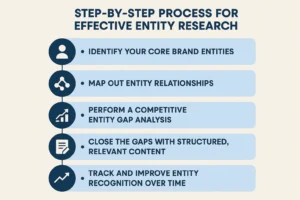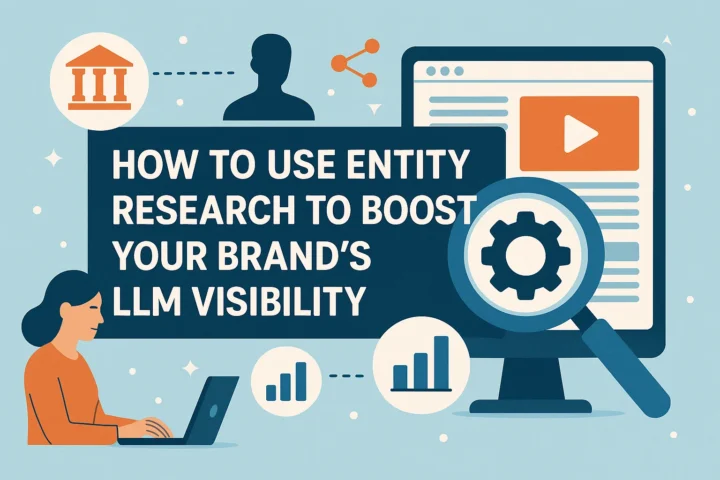Understanding Entity Research in SEO and LLMs
When you need your brand to be visible in not just Google results, but also AI-generated results, that’s where LLM ( Large Language Model) Optimisation stand out. Because in today’s world, many individuals are choosing to type their doubts in LLM-powered models like ChatGPT and Gemini, instead of Google. So, to help maximise brand visibility, brand LLM optimisation is a must. And a key feature that makes it possible is entity research. But first—what exactly is an entity? In simple terms, an entity refers to anything like a person, place, company, or concept that can be easily recognised by models to help your brand show up on both search engines and LLMs alike.
Traditional SEO is more about focusing on keywords, but LLM entity optimisation, on the other hand, helps give AI context and links your brand to related topics so it can understand and suggest it.
Why Entity Research Matters for Brand Visibility in LLMs
Did you know that there is a clear difference between the way LLMs and normal search engines function? LLMs will provide you with answers based on known entities, such as people, brands, products, ideas and the relations between them. Here’s why it’s important from a search perspective:
- How Entity Recognition Shapes AI Responses: Clarity is key in terms of your brand’s entity. It needs to be properly verified and defined in a clear, structured manner for AI to include it in its answers.
- Building Strong Semantic Authority: When your brand is linked to well-known and reputable entities, it helps gain more credibility, increasing your own brand’s relevance in a competitive crowd of many.
- Expanding Visibility Across Multiple Channels: The clearer you define your entity, the more it appears in search results, including not just AI answers, but also in voice search, search engine snippets, Google’s AI-powered results, and other AI tools.
Step-by-Step Process for Effective Entity Research

Looking to boost your AI SEO strategy? Then, here’s how you can help achieve it, because entity research is not just a one-time process, but a constant ongoing process with a clear plan involved:
- Step 1: Identify Your Core Brand Entities
Name your brand and products, your leadership team, the industries and technologies that are connected to your business, and the main problems your customers are having that you can solve. You can check out how AI understands your brand right now with tools like InLinks, Wikidata, or the Google NLP API.
- Step 2: Map Out Entity Relationships
Use visual charts or spreadsheets to show how topics related to entities are linked. To give you an example, consider:
- Parent → Child: E-commerce Platform → Inventory Management → Shopify Integration
- Topic Groups: Digital Marketing → Content Strategy → Video Marketing
- Step 3: Perform a Competitive Entity Gap Analysis
See which entities competitors rank for in AI answers, and you can go ahead and use Frase or MarketMuse to spot topics or connections missing from your own brand’s content.
- Step 4: Close the Gaps with Structured, Relevant Content
Publish expert-level content on the missing topics, add schema markup for clarity, and create industry insights or case studies to boost authority and LLM recognition.
- Step 5: Track and Improve Entity Recognition Over Time
If you want to see if your main topics are properly tagged or if your brand is in the right category, you can use Google NLP Explorer, Diffbot, or IBM Watson Discovery to track this. If you need to, change the content and internal links to help keep entity signals strong.
Integrating Entity Research into Your LLM Optimisation Strategy:
To ensure you get the best results for artificial intelligence for SEO, here are some ways to go ahead and enhance your Brand LLM Optimisation:
- Match Content to LLM Query and Prompt Patterns
With LLMs, they are tailored to understand everyday language, so make sure your content includes naturally sounding answers and real-world examples, be it in the headings or structure, to increase its relevancy for AI to quote your answers.
- Create Topic Clusters Based on Entities
To show your depth, help your brand seem like an expert, and to gain more credibility, you should choose a main topic and then break it down into smaller but related topics. To understand with an example, let’s consider if your main topic is Cybersecurity, you might also write about Ransomware Prevention, Endpoint Protection Tools, and Data Backup Best Practices.
- Implement Schema Markup and Structured Data
A key tip for brand LLM optimisation also includes using schema markup on your pages, helping search engines get a clear idea of what exactly your content covers, thereby making it easier for AI to grasp the context of your content better to increase visibility in search results. The useful types of schema you can include in your content are:
- Organisation, Person, Product, Service
- FAQPage, HowTo, BlogPosting
- SameAs tags to link to your social profiles or trusted sources
- Boost Entity Signals with External Mentions and Citations
With LLMs, they can trust information which they can confirm from public sources. That is why, make sure to get your brand listed on sites like Wikidata, Crunchbase, and industry-specific directories, while also earning mentions and links from trusted publications to help prove your authority.
Conclusion
One of the best ways to make your brand stand out in both natural search results and results made by AI is through entity research. LLMs like ChatGPT, Gemini and so on will only understand and feature your brand more often if you find your key brand entities and link them to important topics. In the world we live in now, where AI rules, we realise that the best way to reach more people, gain their trust, and keep them interested is by combining standard SEO with brand LLM optimisation and entity research.
That is why, to ensure your brand stays up-to-date and trustworthy, there is a simple process involved, which includes: finding entities, mapping relationships, looking at competitors, filling in content gaps, and keeping track of progress. In addition to this, adding schema markup, matching content to natural questions, and getting mentions from trusted sources all help to raise exposure even more.

